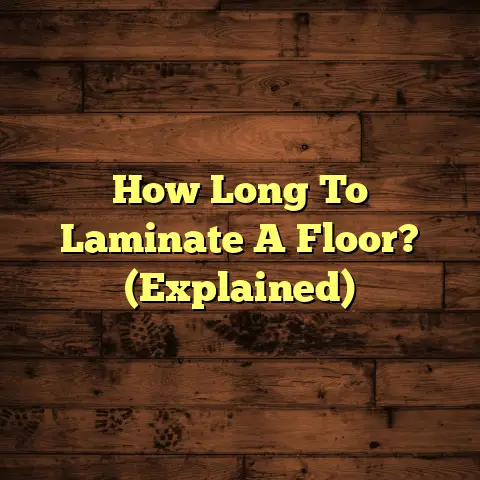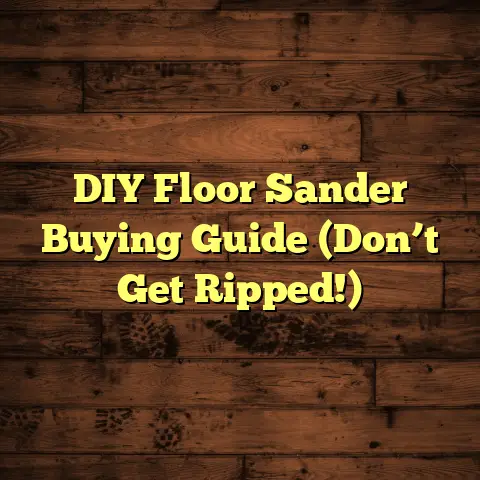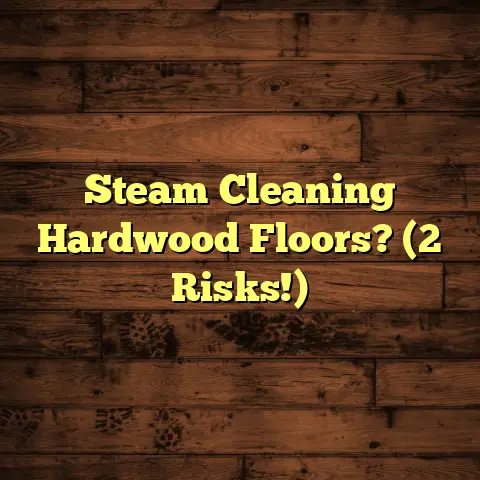Best Carpet Padding Types? (9 Must Know!)
Have you ever walked into a room and just felt the plushness under your feet? That’s often the magic of great carpet padding! But have you ever stopped to think about how your lifestyle affects your choice of carpet padding?
Whether you have kids turning your living room into a playground, pets who think your rug is their personal bathroom, or you love hosting game nights, the right carpet padding can significantly enhance your comfort and the longevity of your flooring.
As a flooring contractor with years of experience, I’ve seen firsthand how the right padding can make or break a carpet installation. Let’s dive into the world of carpet padding and find the perfect fit for your home.
Section 1: Understanding Carpet Padding
So, what exactly is carpet padding?
Simply put, it’s the cushion that lies between your carpet and the subfloor. Think of it as the unsung hero of your flooring system.
It’s not just about making your carpet feel softer (though that’s a big part of it!).
Carpet padding plays a crucial role in:
- Comfort: It’s what makes your carpet feel luxurious underfoot.
- Insulation: It helps keep your home warmer in the winter and cooler in the summer, potentially saving you money on energy bills.
- Noise Reduction: It absorbs sound, making your home quieter and more peaceful.
- Carpet Longevity: It protects your carpet from wear and tear, extending its lifespan.
The type of padding you choose can significantly impact how well your carpet performs in all these areas. Choosing the wrong padding can lead to premature wear, discomfort, and even void your carpet’s warranty! I’ve seen it happen.
Section 2: Types of Carpet Padding
Alright, let’s get into the nitty-gritty. There’s a whole world of carpet padding out there, and it can be overwhelming. Here are the 9 main types I recommend, along with their pros, cons, and ideal uses.
1. Frothed Foam Padding
- Description: This type of padding is made by whipping air into a liquid foam mixture, creating a lightweight, airy cushion. It’s typically made from polyurethane.
- Benefits: Frothed foam offers good comfort and support at a relatively low cost. It’s also resistant to moisture and mildew.
- Ideal Uses: I often recommend frothed foam for bedrooms and living rooms with moderate traffic. It’s a good all-around option for homeowners on a budget.
- Real Talk: While affordable, it might not hold up as well in high-traffic areas compared to denser options.
2. Rebond Padding
- Description: Rebond padding is made from recycled foam scraps that are bonded together. You’ll recognize it by its multi-colored appearance.
- Benefits: It’s an environmentally friendly option (made from recycled materials!) and offers excellent durability and support. It’s also one of the most affordable options.
- Ideal Uses: Rebond is a great choice for high-traffic areas like hallways, stairs, and family rooms. It’s also a good option for homes with kids and pets.
- Real Talk: Rebond can feel a bit firmer than other types of padding, but its durability makes it a popular choice.
3. Memory Foam Padding
- Description: Just like the memory foam in your mattress, this padding conforms to your body, providing exceptional comfort and support.
- Benefits: Unparalleled comfort! It’s like walking on a cloud. It also helps to reduce pressure points and can be beneficial for people with joint pain.
- Ideal Uses: I recommend memory foam for bedrooms and home theaters where comfort is a top priority.
- Real Talk: Memory foam is one of the more expensive options, and it may not be the best choice for high-traffic areas as it can compress over time.
4. Rubber Padding
- Description: Rubber padding comes in two main types: waffle rubber and flat rubber. Waffle rubber has a textured surface, while flat rubber is smooth.
- Benefits: Rubber padding is extremely durable, resilient, and provides excellent support. It’s also resistant to moisture and mildew.
- Ideal Uses: I often use rubber padding in commercial settings and high-traffic areas like hallways and entryways. It’s also a good choice for basements.
- Real Talk: Rubber padding can be more expensive than other options, and it may have a slight odor initially.
5. Fiber Padding
- Description: Fiber padding is made from natural or synthetic fibers, such as jute, wool, or synthetic blends.
- Benefits: Fiber padding is a good choice for people with allergies, as it’s naturally hypoallergenic. It’s also environmentally friendly and offers good support.
- Ideal Uses: I recommend fiber padding for bedrooms, living rooms, and homes with allergy sufferers.
- Real Talk: Fiber padding can be more expensive than synthetic options, and it may not be as resistant to moisture as other types.
6. Crumb Rubber Padding
- Description: Crumb rubber padding is made from recycled tires, making it an incredibly sustainable choice.
- Benefits: This padding is extremely durable and provides excellent shock absorption. It’s also resistant to moisture and mildew.
- Ideal Uses: Crumb rubber is a fantastic option for gyms, playrooms, and other areas where impact absorption is important. I’ve even used it in some home theaters for sound dampening.
- Real Talk: It can be quite dense and firm, so it might not be the most comfortable option for all areas of the home.
7. Urethane Foam Padding
- Description: Urethane foam padding is a versatile option that comes in various densities and thicknesses.
- Benefits: It’s a good all-around choice that offers a balance of comfort, support, and affordability.
- Ideal Uses: Urethane foam padding can be used in a variety of rooms, including bedrooms, living rooms, and family rooms.
- Real Talk: The quality of urethane foam can vary, so it’s important to choose a reputable brand.
8. Synthetic Padding
- Description: This category encompasses padding made from various synthetic materials, often blends designed for specific performance characteristics.
- Benefits: Synthetic padding can be engineered for specific needs, such as enhanced stain resistance or improved airflow.
- Ideal Uses: Depending on the specific blend, synthetic padding can be used in a variety of rooms. Look for options tailored to your specific needs.
- Real Talk: Always check the manufacturer’s specifications to ensure the padding is suitable for your carpet type and intended use.
9. Natural Padding (e.g., Wool)
- Description: Wool padding is a luxurious and sustainable option made from natural wool fibers.
- Benefits: Wool padding is naturally hypoallergenic, flame-resistant, and provides excellent insulation. It’s also incredibly comfortable and durable.
- Ideal Uses: I recommend wool padding for bedrooms, living rooms, and high-end homes where quality and sustainability are top priorities.
- Real Talk: Wool padding is one of the most expensive options, but its benefits make it a worthwhile investment for many homeowners.
Section 3: Factors to Consider When Choosing Carpet Padding
Okay, now that you know about the different types of padding, how do you choose the right one for your home? Here are some key factors to consider:
- Family Size and Activity Level: A busy household with kids running around will need a more durable padding than a quiet home with just one or two adults.
- Presence of Pets: Pets can be tough on carpets and padding. Look for padding that’s stain-resistant and moisture-resistant to prevent accidents from soaking through.
- Allergies and Sensitive Skin: If you or anyone in your family has allergies, choose a hypoallergenic padding like fiber or wool.
- Budget Considerations: Carpet padding prices can vary widely, so set a budget before you start shopping. Remember that investing in a higher-quality padding can save you money in the long run by extending the life of your carpet.
- Desired Carpet Longevity and Maintenance: The right padding can significantly extend the life of your carpet. Choose a padding that’s designed to withstand the level of traffic in your home.
Section 4: Benefits of Choosing the Right Carpet Padding
Investing in high-quality carpet padding is one of the smartest things you can do for your floors. Here’s why:
- Enhanced Look and Feel: The right padding can make your carpet feel more luxurious and comfortable underfoot.
- Improved Durability: Padding protects your carpet from wear and tear, extending its lifespan. I’ve seen carpets last years longer with the right padding underneath.
- Insulation: Padding helps to insulate your home, keeping it warmer in the winter and cooler in the summer.
- Energy Savings: By improving insulation, padding can help you save money on your energy bills. According to the U.S. Department of Energy, proper insulation can reduce energy consumption by up to 15%!
Section 5: Installation Tips for Carpet Padding
Alright, let’s talk installation. While you can hire a professional (and I often recommend it!), here’s a basic overview if you’re feeling ambitious:
Tools Needed:
- Utility knife
- Measuring tape
- Staple gun
- Staples
- Seaming tape
Step-by-Step Guide:
- Prepare the Subfloor: Make sure the subfloor is clean, dry, and free of debris.
- Measure and Cut: Measure the area where you’ll be installing the padding and cut the padding to size, leaving a slight overlap.
- Install the Padding: Roll out the padding and secure it to the subfloor using a staple gun.
- Seam the Edges: Use seaming tape to join the edges of the padding together, creating a smooth, seamless surface.
- Trim Excess: Trim any excess padding around the edges of the room.
Common Mistakes to Avoid:
- Skipping Subfloor Prep: A dirty or uneven subfloor can cause problems with the padding and carpet.
- Using the Wrong Staples: Use staples that are the correct length for the thickness of the padding.
- Not Seaming Properly: Gaps in the seams can cause the padding to shift and wear unevenly.
Section 6: Maintaining Carpet Padding
To ensure your carpet padding lasts as long as possible, follow these maintenance tips:
- Regular Vacuuming: Vacuum your carpets regularly to remove dirt and debris that can damage the padding.
- Professional Cleaning: Have your carpets professionally cleaned every 12-18 months to remove deep-seated dirt and stains.
- Spot Cleaning: Clean up spills immediately to prevent them from soaking into the padding.
- Regular Inspections: Check your carpets and padding regularly for signs of wear and tear.
Section 7: Conclusion
Choosing the right carpet padding is an essential step in creating a comfortable, durable, and beautiful flooring system. By considering your lifestyle, budget, and desired level of comfort, you can select the perfect padding to enhance your home and extend the life of your carpet.
Remember, it’s not just about the carpet you choose, but what’s underneath that truly makes a difference.
Call to Action:
So, what are your flooring needs? Are you looking for plush comfort, unbeatable durability, or a budget-friendly option? Take some time to assess your lifestyle and preferences, and then start exploring the world of carpet padding. Your feet (and your wallet!) will thank you. Now go make your flooring dreams a reality!





